Writing
Looking for inspiration, design tricks, how to make a great cover, promoting your yearbook and engaging your community?
Most recent

Why your yearbook writing needs the inverted pyramid
The easiest way to hook your reader is to use a yearbook writing technique that’s used by the pros: Put the most important stuff first.
You and your yearbook team have limited time to capture a reader’s attention—and, perhaps more importantly, limited space to tell your story—so you should be focused on hitting them with the big stuff right out of the gate.
In journalism, this writing technique is known as the inverted pyramid. In military and government briefs, it’s known as BLUF (Bottom Line Up Front).
Because the yearbook is journalistic in nature, we’ll be sticking with the term “inverted pyramid” throughout this post. But know this: Whatever you call it, the technique is an effective means of communication. And it’s one your team can use when looking to improve its yearbook writing.
Inside this post, we’ll walk you through what the inverted pyramid looks like and how you can break it down into manageable chunks.
What The Inverted Pyramid Looks Like
When it comes right down to it, the organization of your yearbook writing should look like this:
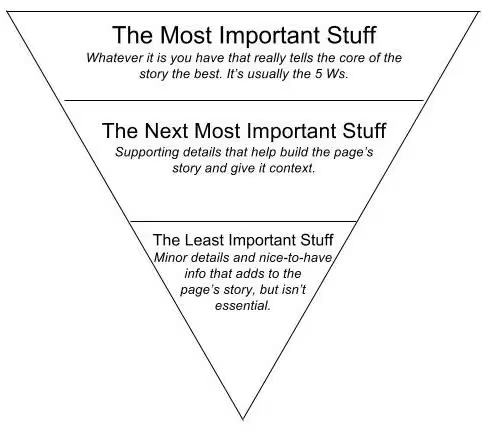
That’s an inverted pyramid.
It’s a three-tiered writing diagram that forces the most important stuff to the very top and the remainder of the story’s details into the two remaining tiers.
How to Use The Inverted Pyramid in Your Yearbook Writing
This approach to yearbook writing might sound obvious (or maybe even boring), but plenty of student journalists will try to tell a story in chronological order. Help them avoid that by showing them this diagram.
Put The Most Important Stuff First
Your opening lines, or the lead, as it’s often known, should immediately state what’s special about the article. What was different about the event this year as opposed to last year? What makes this story noteworthy?
The lead should cover most of the five Ws: Who, What, When, Where and Why. These elements provide the biggest, most important pieces of information, and should be introduced early in your article.
The more interesting the news, the more reader will want the details. You’re not writing a mystery novel, so don’t try to tease your audience with page-turning suspense. You’ve got a limited time to capture their attention, so hit them with the big stuff right out of the gate.
Put The Next-Most Important Stuff Second
Now that the reader is invested in the story, this is a great space to share more about the event or achievement, and the students that were involved.
After reading the headline and the lead, readers will get the basics of what happened. The middle section is your opportunity to tell more of a story. You can also expand a bit more on the how.
You can do this in a few ways, but some of the most proven tactics include:
- Relying on first-hand accounts. Relying on interviews with students and participants can help you paint a picture of what an event felt like to those who experienced it. Quotes, in particular, can help evoke emotion, which is a strong way to keep readers engaged.
- Including background details. If you can continue to build on your 5 Ws, all the better. Background details, like the time left on the clock when the basketball team scored the championship-winning basket or the number of hours it took the stagehands to build the set for the school play, helps propel a story along and give the reader a deeper understanding of what happened and why you’re writing about it.
- Using pull-quotes. Really great quotes can do more than just evoke emotion. They can also be used to break up text and add some design elements to your page or spread. Think of a pull-quote as another entry point for the reader.
Just as in the overall structure of the inverted pyramid, the middle section should begin with the most important details, and cascade down to the less essential stuff. There aren’t clear breaks between beginning, middle, and end sections, so you don’t have to worry about where one section ends and the next begins.
Put The Least-Most Important Stuff Last
If you’ve really captured your reader’s attention, they’re going to be hungry for every little bit of information they can get. (You know the binge TV watcher who seeks out fan forums online? Or the Belieber who knows lyrics to the songs that didn’t make Justin Bieber’s album? That’s the type of reader who stays until the end.)
The more you can attract an audience with the big hits, the more you can interest them in the details.
Details that would otherwise be left out belong at the end. They might be interesting, but if you need to cut them for space, it’s no big deal. Of course, you’ll want to leave the readers satisfied, so if you can finish with any kind of pithy or clever line, that will make them more likely to read your next article from start to finish. A retrospective or forward-looking quote from a student is also a nice way to draw each piece to a close.
Chances are your pages won’t be filled with text, but you’ll want to share what you’ve got in a way that makes sense. If you follow this simple formula, you’ll not only be able to highlight the year’s most memorable moments, you’ll also develop a clear and valuable method of yearbook writing from top to bottom—and that’s the point.

Yearbook in 60 days: part 4 - proofreading and going print ready
This is the final installment in a four-part series on creating a yearbook in 60 days. By now, portraits and spreads are in the book, and it is time to polish both. Day 46-60 tasks center around communication to parents and the print process.
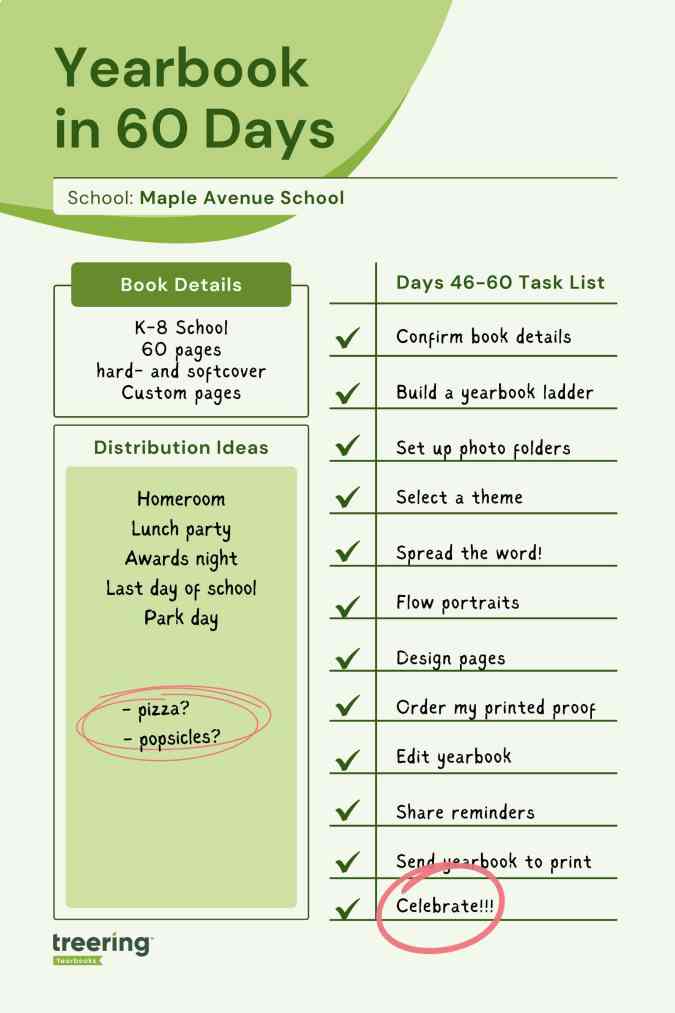
Yearbook (yes, it is a verb) along with us on Facebook, Instagram, and TikTok.
1. Custom Page Reminders
Marketing Rule of Seven aside, parents are busy. Teachers are solving the world’s problems. We need reminders (not the “loving” ones that are really sassy in disguise). Remember the parent purchase date you set during days 1-15? This is the date by which parents should customize and purchase their yearbooks.
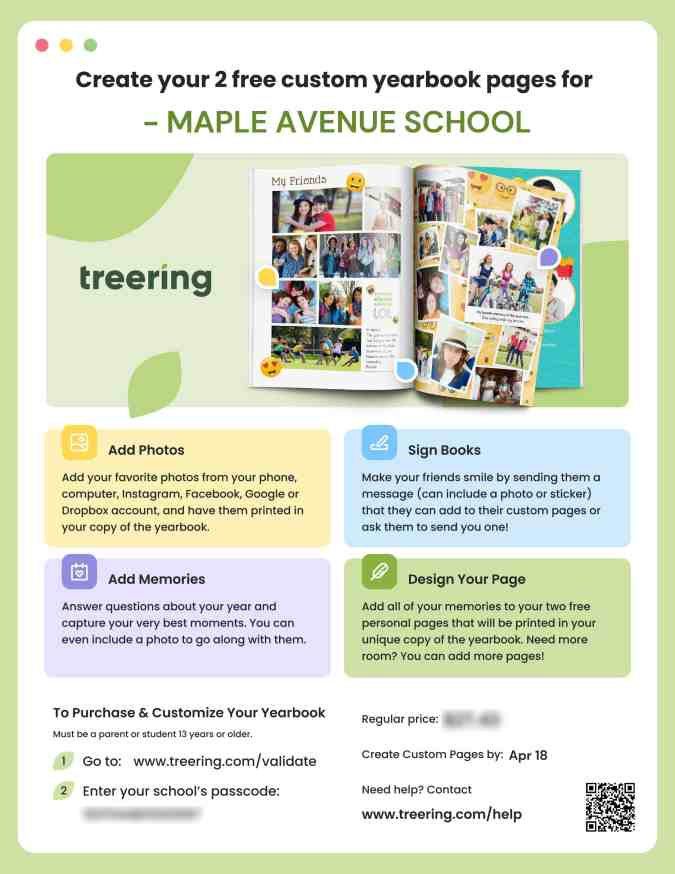
While parents do not have to fill their free, two custom pages with memories, a little education goes a long way. Here are a few ideas for reminders:
- Include a flyer in the monthly newsletter
- Share a video tutorial on your parent group’s social media page
- Create a virtual parent event aligned with one of Treering’s parent webinars to “attend” together
- Host a custom pages night and walk parents through the process
Custom Page Resources
Remember, you must use the login button to access the editor articles.
- Editor Video: Reviewing All Students' Custom Pages
- Parent Video: Creating Custom Pages with Page Builder
- Parent Video: Creating Custom Pages from Scratch with Page Editor
- Spring Parent Webinars: Yearbook Club
2. Make Corrections
Continue using those PDF proofs and the page warning tray to manage duplicate images, low-resolution images, margin warnings, and spelling errors.
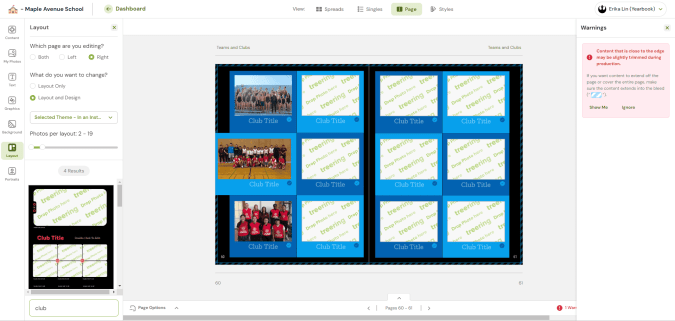
Page Warning Tray Resource
- Editor video: Page Warnings
3. Print Ready Process
You tell Treering when to begin the printing process. When your Finish Editing Yearbook Deadline arrives, your yearbook does not automatically head to the printers. Remember, your three-week turnaround begins from the date you send the book to print.
It will take 15-20 minutes for you to complete the pre-print process below.
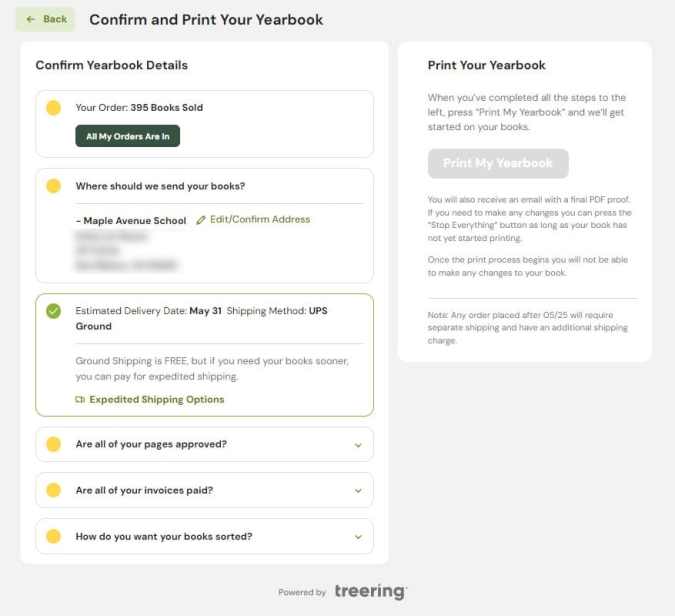
After you complete the checklist and select the dancing “Print my Yearbook” button (cue the confetti), you will receive an email with your final-final PDF proof and instructions if you find a grievous error and need to stop the printing process. There is an extremely short, blink-and-it's-over window to do this; it may cause production delays.
Sending Your Yearbook to Print Resource
4. Never Say, “No.”
You will never have to turn away a student at a Treering school who wants a yearbook after the print deadline. With Treering, you can even order and personalize past years’ books.
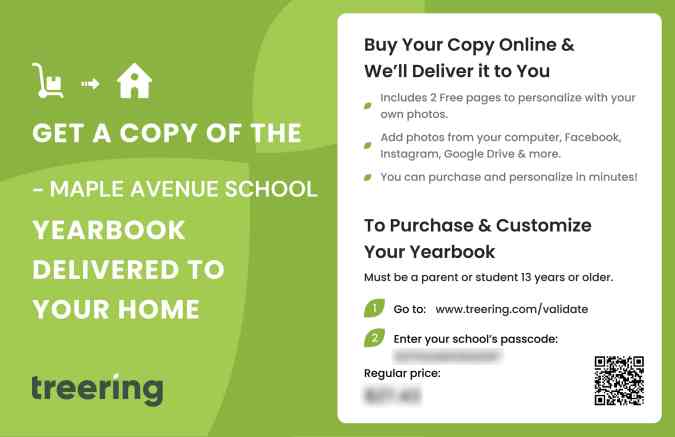
Additionally, with the fundraiser and book donation options, you can ensure students in need have books as well.
Post-Print Ready Resources
- Parent Video: Buying a Yearbook for a Previous School Year
- Article: After Deadline Orders
- Video: Fundraiser Disbursement Options When Setting Your Yearbook to Print Ready
- Case Study: Yearbook Hero Janet Yieh Gives Away Yearbooks
Feeling Adventurous? Plan a party!
Yearbook signing parties need not be extravagant: tables, pens, tunes.
Yearbook Signing Party Resources
You did it! How will you celebrate building a yearbook in 60 days? Be sure to tag @treering on Facebook and @treeringcorp on TikTok and Instagram to show us. Happy yearbooking!

10 people to thank
‘Tis the season to show appreciation. A quick internet search nails myriad resources outlining how regularly expressing thanks can positively impact one's mental health and overall well-being. That’s why we created the yearbook thank you shortlist.
Below are ten people to thank who may have made a significant impact on the yearbook students' productivity:
- Custodial and maintenance team: Appreciate the custodial and maintenance team for their hard work maintaining a clean and functional school space, which creates a conducive environment for creativity and collaboration.
- Administrative staff: Extend thanks to the administrative staff for their behind-the-scenes efforts in answering all the, “Did I buy a yearbook?” calls while serving as a veritable who’s who for campus activities. Seriously, every campus has that one seasoned staff member who knows all the kids' names and helps you proof the yearbook, and chances are she’s running point in the front office.
- Teachers: Thank teachers and instructors who opened their doors for yearbook interviews and shared photos of their classroom happenings. They’re the yearbook heroes who pitch their upcoming projects and presentations as photo opportunities, and they use the Treering App to upload great pictures from their field trips.
- School librarians and media specialists: Thank the school librarian for their assistance in research, providing valuable resources, and supporting the yearbook team in gathering information and materials, including tech tools.
- Principal and assistant principals: Express gratitude to the admin team for their leadership, support, and commitment to fostering an environment where creative projects like the yearbook can thrive. (Bonus points if the principal and/or AP also ensure the yearbook photographers get good angles for snapping action shots during fun school events.)
- Cafeteria staff: Thank the cafeteria staff for their role in keeping students well-nourished and providing energy and sustenance during busy yearbook project periods.
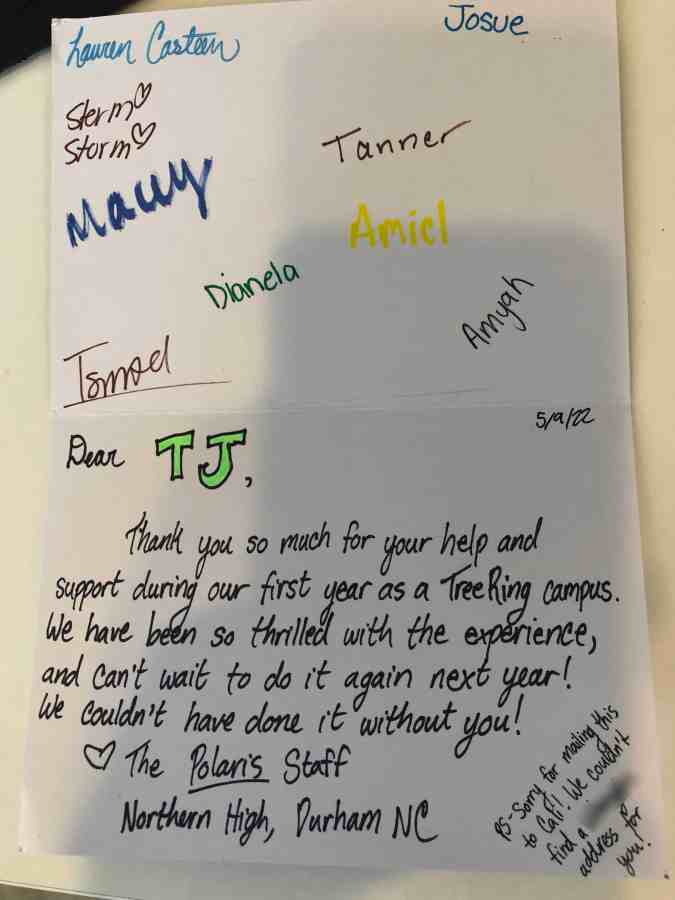
- Parents and guardians: Extend thanks to those who bought their book by the deadline for supporting history-in-the-making with the yearbook, that mom with the nice DSLR camera who is at all the events taking great pictures, and the parents who added 30 extra custom pages making their childrens’ books double the size!
- Anyone who responded to a crowdsourcing request: Express thanks to the contributors for their valuable insights, diverse perspectives, and the depth they brought to the yearbook.
- Student body: Express thanks to the entire student body for their active participation, cooperation, and enthusiasm, making the yearbook a true representation of the collective experiences and memories of the school year. (We’re talking to you, middle schooler, who think it so "cringy" when your mom is on campus taking pictures for the yearbook that you won’t even wave at her. You’ll thank us later.)
- Yearbook publisher: Acknowledge the service, printing, and production teams for their hard work in bringing digital designs to life, ensuring your school’s yearbooks are of the highest quality.
To demonstrate gratitude, your yearbook team can write a card, decorate a gratitude wall in the hallway, or sponsor a lunch or coffee hour.

Making yearbooks more accessible with opendyslexic
Fonts can be the Marsha Brady of the yearbook world. Overshadowed by epic theme packages and color palettes, the power of typography cannot stay silent. (In fact, the correct font can be louder than your graphics.) With 44 new fonts in the Treering catalog, you can share your story with boldness or a touch of whimsy. It can be focused or zany, handwritten or high-tech.
“Typography, like other design elements, evolves over time. Keeping up with current trends ensures that your designs feel fresh, relevant, and aligned with contemporary aesthetics,” Treering’s Director of Design, Allison V. said. “Typography also strongly impacts how a message is conveyed and perceived. More importantly, we listen to our users and try to accommodate their needs and wants. We often receive requests for fonts and appreciate the input from you.”
One such request came in the form of a text.
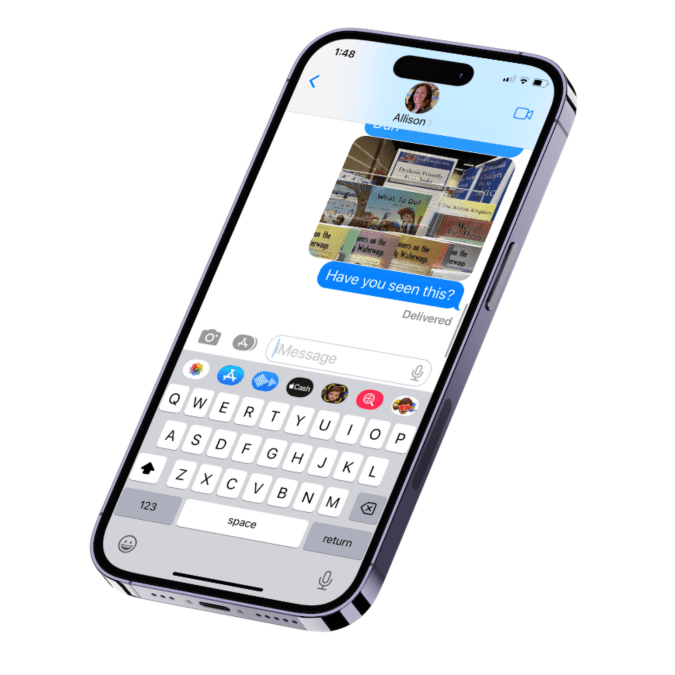
Meet OpenDyslexic
Since origin stories are a big deal in the superhero world, here is OpenDyslexic’s: app and game designer Abelardo “Abbie” Gonzalez developed the font in 2011 to help people with dyslexia improve their reading experience.
OpenDyslexic’s design addresses common challenges faced by many readers with dyslexia:
- Letter Weight: OpenDyslexic uses a slightly heavier letter weight, which helps the letters stand out more clearly on the page and reduces letter crowding. When designing for readers with dyslexia, avoid using italics or underlines because they cause letter crowding.
- Bottom Heavy: The base of the letters is slightly thicker, which provides better anchoring for letters. This can reduce the chances of them being flipped or reversed.
- Distinct Letter Shapes: The font uses distinct letter shapes to minimize letter confusion, such as avoiding mirror-image similarities between letters like "b" and "d."

Because it’s an open-source font, it is freely available. You can even make it your web browser’s font.
How Would You Use OpenDyslexic in Yearbook Design?
The short answer: headlines and captions.
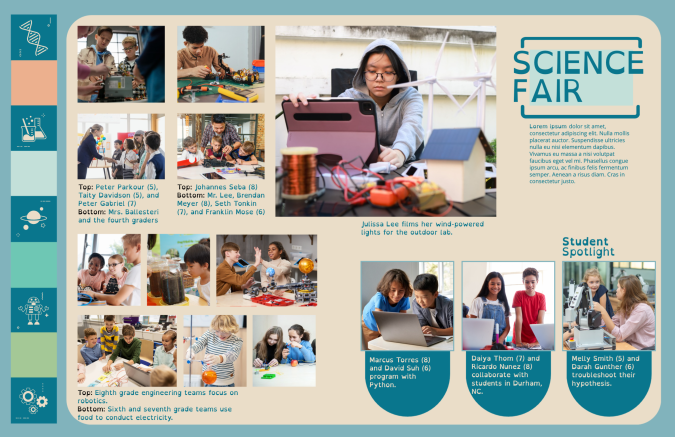
The British Dyslexia Association and the UX Movement established Dyslexia-Friendly Style Guides. Summed up, the following tips can increase the readability of your spreads.
- Modular design: use negative space to break up content into meaningful chunks
- Keep backgrounds to a single color, ideally cream or pastel peach, orange, yellow, and blue
- For text, ensure there is contrast between the background and words on your yearbook spread
- Left align text
- Use font size 12-14 pt.
As with anything, it is essential to note that while dyslexia-friendly fonts and design can be beneficial for some individuals, there is no one-size-fits-all solution for all learners. If possible, seek stakeholders' feedback during the design process to identify potential improvements.
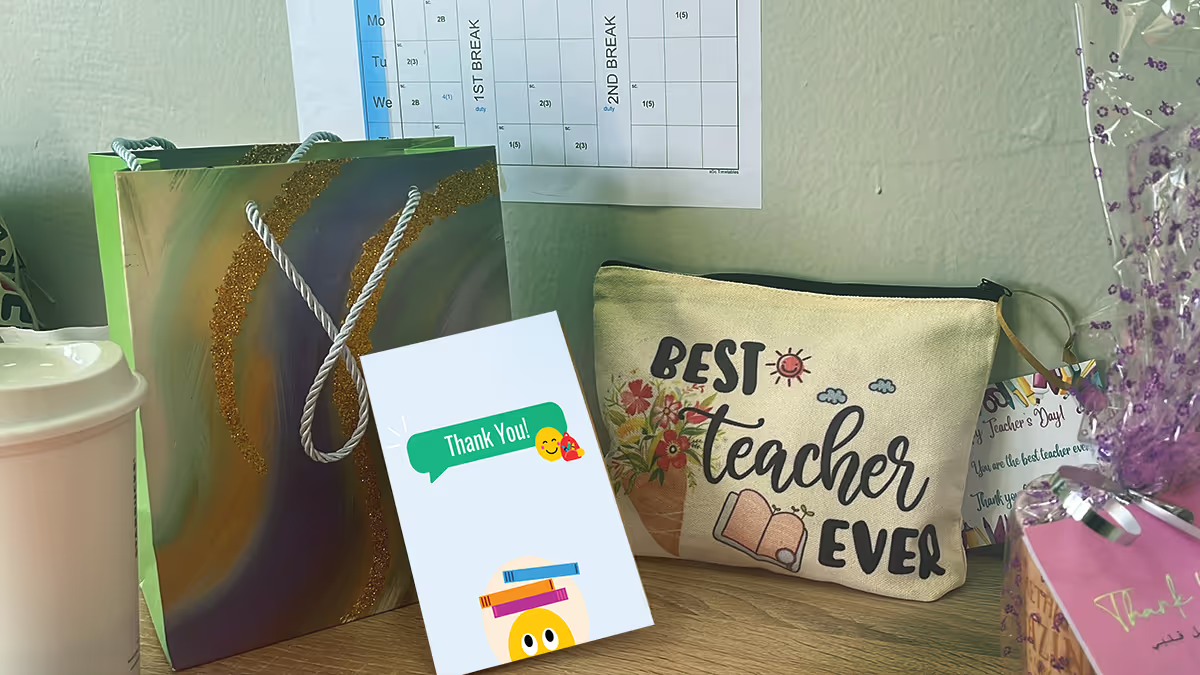
Teacher appreciation printables
By participating in Teacher Appreciation Week, students and parents recognize the efforts of their teachers. We’ve created two free printables to help make it easy because this week can be a powerful way to build rapport between home and campus life, which can ultimately enhance the learning experience for everyone involved. Additionally, participating in Teacher Appreciation Week can teach students the importance of showing an attitude of gratitude.
The Science Behind Being Thankful
Studies show that when you share gratitude with others, your brain becomes re-wired in a positive way. Gratitude helps you
- Feel happier: Gratitude can make you feel good by making more of the happy chemicals—dopamine and serotonin—in your brain.
- Think better: Gratitude can help you use the prefrontal cortex (thinking part) of your brain more, which helps you make good decisions and solve problems.
- Reduce stress: Gratitude can help you worry less and feel less scared by calming down the part of your brain that makes you feel anxious.
Now that’s something for which to be grateful.
Free Printables
We made these printables available as a convenient way for parents to participate in Teacher Appreciation Week. Simply download and print the materials from the comfort of your own home for your child or work with other classroom parents to cultivate a display on the classroom door in the teachers’ lounge. Whichever you choose, you and your child can personalize the messages, which can make them more meaningful and memorable for the teacher.
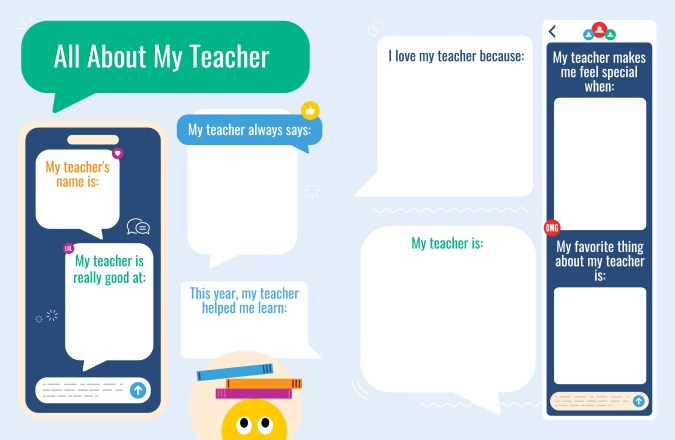
"All About My Teacher" Printable
This full-color mini poster with fill-ins is a fun way for parents and their children to document the impact of their teacher. Download it here. (Did you know this page is also available as a pre-designed yearbook spread you can drag and drop into your Treering yearbook?)
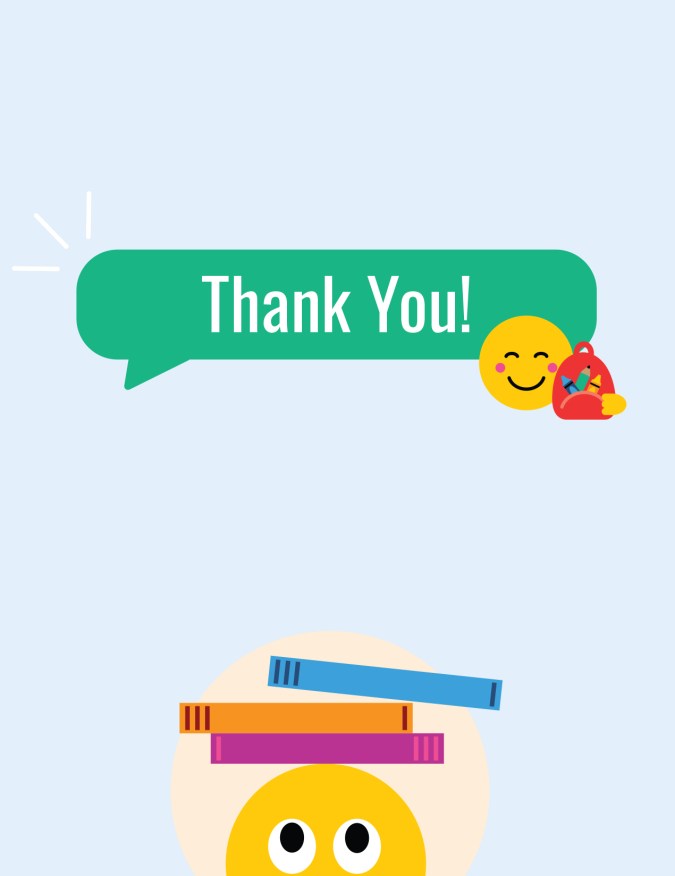
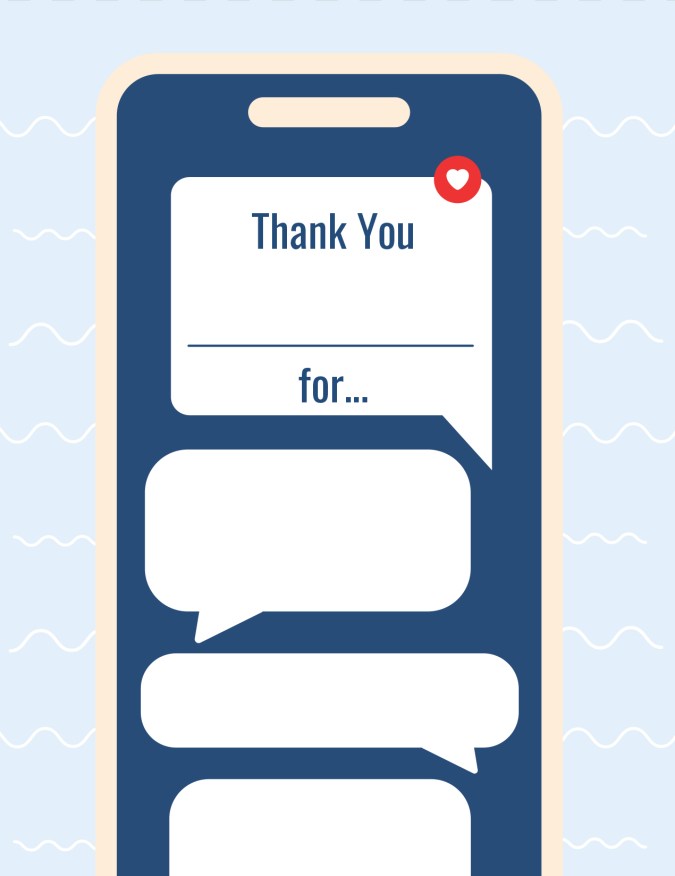
Teacher Appreciation Card
We’ve made it easy to write a letter thanking teachers for all their hard work and dedication. Fill in the blanks of the card below. Thank you cards can be compiled into a scrapbook or displayed in the classroom. Download it here.
We hope these printables help to create a fun and festive atmosphere in the classroom. Teacher Appreciation Week is a way for students and parents to express gratitude towards the teachers who have had a positive impact.
We see you, teachers; your hard work and dedication are recognized and valued.

Yearbook design hierarchy
Design hierarchy of a yearbook spread refers to the arrangement of elements on a page in order of importance, with the most important element drawing immediate attention and receiving support from secondary and tertiary elements. When you apply these design principles, you are taking your readers on a journey across each yearbook spread by telling them where to begin and where to exit each spread through visual cues. Sound complicated? No worries, we'll break it down below.
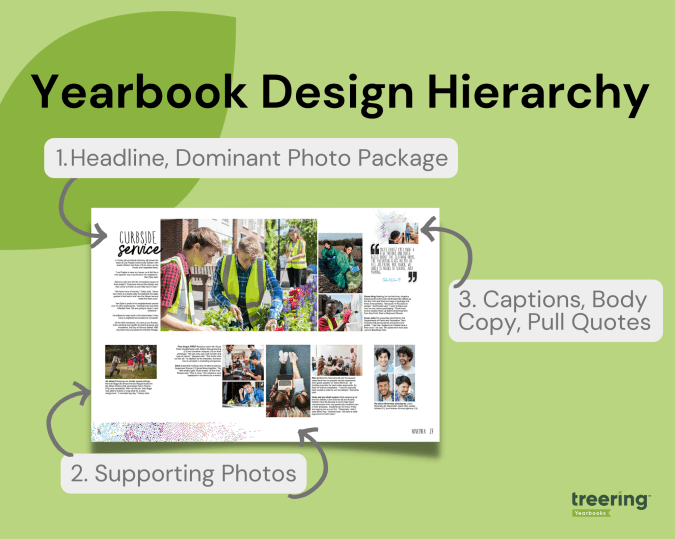
Dominant Elements
Think, "We're #1!" The dominant elements in yearbook hierarchy are headlines, the dominant photo package, and a subheadline. The dominant elements are just that: they dominate the most real estate on the spread. It's from them the rest of the content builds.
Headline
The headline is the most important element on a page and serves as a brief content summary. It should be attention-grabbing and provide an overview of the page's content.
Dominant Photo
This is self-explanatory: the largest photo on the spread is the dominant one. It draws the eye. It connects to the headline. It sets the tone for the entire spread. The best dominant photos are storytelling or action shots.
Subhead
The subhead is a secondary headline that provides more detail and context to the main headline. It can also be used to break up yearbook spreads into smaller sections, or modules.
Secondary Elements
Your secondary elements build from your dominant ones. Think of them as a great ensemble cast.
Photos
For most, photographs are the most important part of a yearbook. The individual images and their positioning on the spread can help further illustrate the page topic and make the page more visually appealing.
Quick tips:
- Eyes should look toward the center of the spread, not off the page
- Similar photos should be in proximity to one another
Tertiary Design Elements
If your headline and photographs did their job, readers will swoop in to enjoy your captions, copy, and extras.
Captions
These beauties provide context and information about the photos on a page, therefore they should be near their respective photograph. While they should be concise and well-written, it's easy to get cliche: "Tomás Bernal (7) enjoys his lunch." Start with the 5 Ws and then up your caption game by adding expanded captions.
Body Copy or Yearbook Stories
This is the main text on a page and provides the details and information about the subject being covered. It should be well-written, easy to read, and relevant to the headline and dominant topic of the spread. Often, when a dominant photo is of the storytelling variety, it will complement it and further explain its significance.
Sometimes, an "ident caption" will suffice. This is a list of names of students pictured, including their grade. In the middle school book below, the yearbook team used ident captions to outline the event program from the annual fundraiser.

Pull Quotes
Pull quotes are quotes from the body copy that are set off visually and used to highlight important or interesting information or one-off quotes from a student. They have both visual and verbal significance because they highlight the spread's topic with a unique POV. They can also add to the overall theme by bringing in theme elements.
Graphics and Design Elements
Like everything in yearbook design hierarchy, graphics and design elements, such as borders, backgrounds, and page numbers should be intentional. It's easy to get out of hand with Treering's graphics library, so that's why our design team cultivated 300-ish fully editable themes and color palettes for you. The purpose is to make the page more visually appealing and easier to navigate while telling the story of your year.


The hierarchy of a yearbook spread can vary depending on the page's content, and following this basic structure can help ensure that the page is well-organized and easy to read. If you're teaching yearbook or leading a club, use it
- As a checklist for students who are beginning to design
- For a scavenger hunt to see who can identify elements on a spread in a magazine or another school's yearbook
- To build your program by strengthening yearbook hierarchy in each design
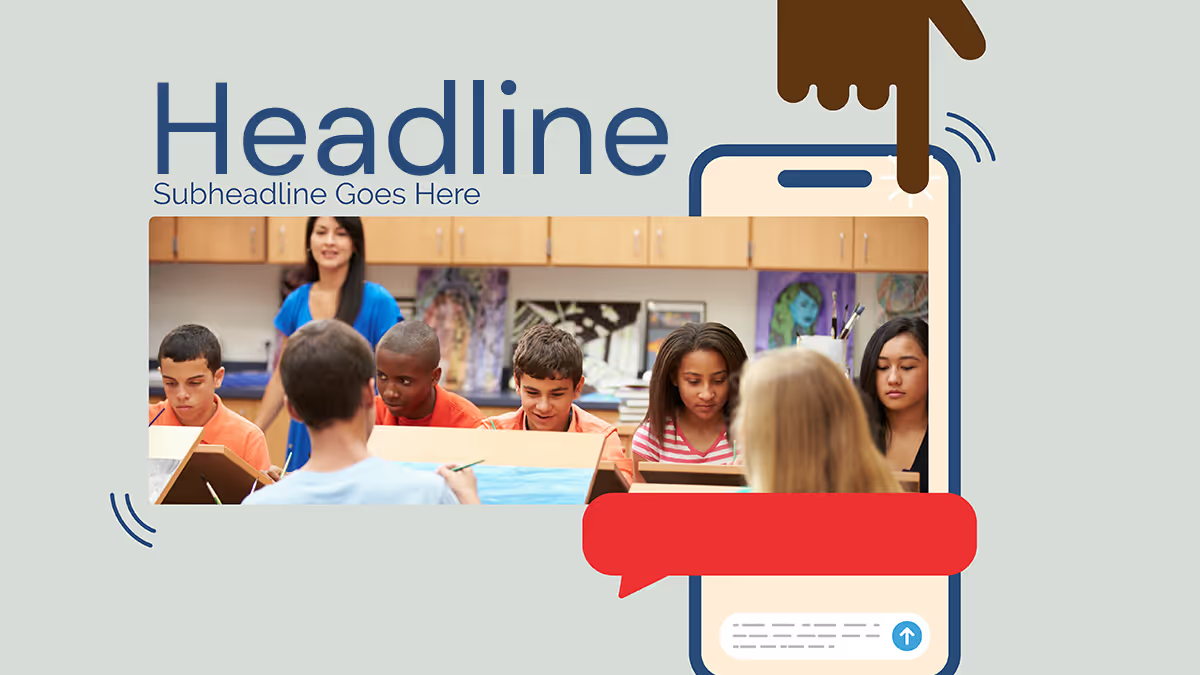
How to write yearbook headlines
Not only is it a part of the dominant element of your spread’s hierarchy, but headlines also help organize the yearbook by providing a visual cue and structure for the content. An effective headline can help a reader quickly understand the content of a page and decide if they want to read more. (They should!) When writing headlines for your yearbook, follow these five guidelines.
1. Set the Tone
The tone of your headlines should match the tone of the yearbook, whether it is lighthearted, serious, or something in between.
Many advisers begin the theme development process with an idiom dictionary nearby to create a lexicon for the year. By incorporating keywords and phrases from the yearbook theme into the headlines, designers create a consistent and cohesive story, which ultimately strengthens your theme.
Take a look at this example: with the Treering Theme Stay Gold in mind, the editorial staff looked at all the phrases using gold and built out a list. They then assigned potentials to spreads. Notice how gold is frequently used, as are synonyms such as shine and glitter.
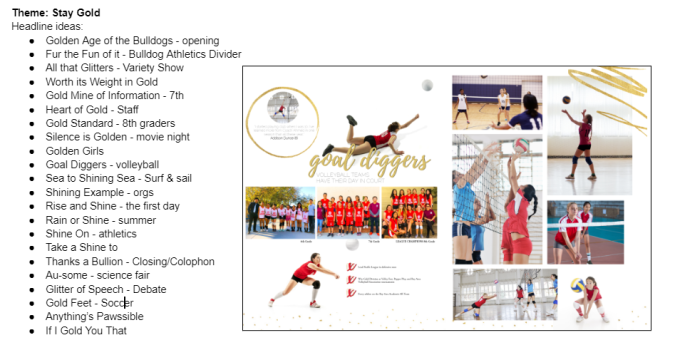
Considerations for Theme Copy in Yearbook Headlines
- Resist the urge to make every headline the same. In a book titled “Then & Now,” you can only have so many headlines with an ampersand. (Trust me, it was a first-year yearbook fail.)
- Use spin-offs to highlight the main concepts of the theme. Your headlines and subheadlines exist to bring the yearbook theme to life and make it an integral part of each story and spread.
2. Maximize Your Space
Focus your yearbook headlines and limit them to no more than a few words which accurately reflect the content of the story they introduce.
Advisers, here are some exercises that can help students produce stronger headlines:
Headline Critique
Have students work in groups to critique headlines written by their peers. Collaboratively, students learn to identify strong and weak yearbook headlines and develop a critical eye for headline writing.
News Scavenger Hunt
Collect headlines from various sources (some ideas are below in section five) and analyze them for clarity, conciseness, and relevance to the content. This exercise can help students understand the importance of writing headlines that accurately reflect the content and grab the reader's attention.
Headline Revision
To help students learn to refine their headline-writing skills and make their headlines more effective, have students write several headlines for a given story or event and then revise them to make them more concise, clear, and attention-grabbing.
3. Follow AP Style guidelines:
When it comes to all things style, the Associated Press Stylebook sets the rules for copy, abbreviations, and formatting.
- Capitalization: Capitalize the first word and all subsequent important words in the headline, including prepositions and conjunctions of four letters or more.
- Active voice: Use active voice in your headlines, as it makes them more dynamic and engaging.
- Punctuation: Limit the use of punctuation in headlines, typically using only a single exclamation point or a question mark, if necessary. (Personal anecdote: My undergrad journalism professor told me I get three exclamation points in my career, and to use them wisely.)
- Conciseness: Keep headlines concise and to the point, typically no more than a few words.
- Spelling and grammar: Make sure to check the spelling and grammar of each headline to ensure that it is error-free and professional-looking.
4. Wordplay Works
Make your English department swoon with literary techniques such as puns or alliteration if appropriate.
While "Football" is a straightforward and accurate way to describe the subject matter, using it as a headline for a story about the football team in a yearbook may not be the most engaging option. To make the headline stand out and capture the reader's attention, it's often better to use wordplay or a more descriptive phrase that goes beyond just the basic name of the subject.
For example, instead of simply using "Football" as the headline, you could use an alliteration that showcases your mascot such as “Lions on the Line” or "Touchdown Titans."
You could even use something from the story copy to tie the spread together: below this cheer spread's feature story is about the relationship between cheer flyers and bases.
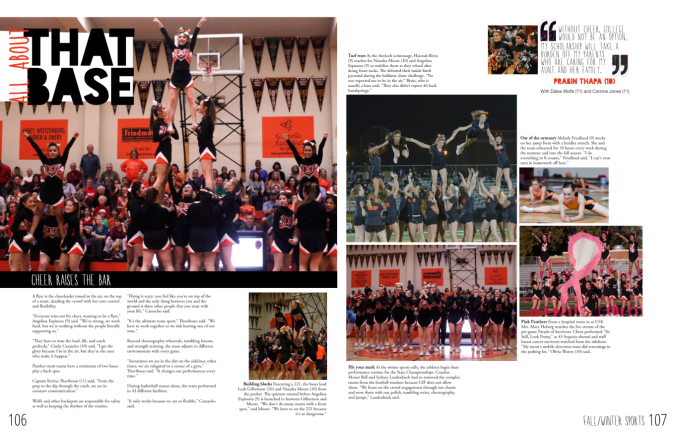
5. Keep Headlines Timely
Consider the current events and trends that are relevant to the yearbook and include them in your headlines. From Homecoming (Game of Thrones) to personality profiles of faculty (How I Met Your Teacher), you can get creative in the Heartland (any location on campus, such as the quad, where the whole school gathers). See what we did there?
Find inspiration by looking at
- News websites and magazines
- Social media platforms
- Advertisements
- Books and novels
- Popular songs, TV shows, and movie titles
- Quotes and (appropriate) jokes
- Previous yearbooks
Following these tips and finding your headline groove will strengthen your yearbook theme and tell the story of your year. For additional writing tips, check out these blogs:

Why I stopped publishing senior quotes
Unpopular opinion: senior quotes are problematic because they are unoriginal and full of risk. Before you click away from this perceived pessimistic view, put on your journalist hat and look at the facts. This position is not an anti-expression rant but a push to develop original, authentic content for our yearbooks. Here’s how I replaced senior quotes 15 years ago.
Three Reasons To Start a New Senior Tradition
1. Participation and Originality
A struggle we see from advisers is a small percentage of students submit their senior quote. Those who do use a quote from a movie, song lyric, or timestamp, not their own thoughts. That’s not journalism. These pop culture references may have a place in a module or personality profile elsewhere in the book if it relates to your theme.
2. Vetting Process
Do you know the periodic table? Are you fluent in slang, TikTok trends, drug euphemisms, and veiled sexual references? Does your district have a hard line on what is free vs. hate speech?
3. Senior Quotes Can Equate to Bad PR
A quick news search for "yearbook senior quotes" yields myriad results of senior quotes gone wrong. Allegations of bullying in the yearbook and “unlawful accessing” the online editor abound. Schools have even cut the pages from their books due to the quotes in print.
Ideas to Replace Senior Quotes
Thanks for sticking with me. Below are ways to celebrate the seniors on your campus and capture their voices (rather than Michael Scott’s).

Brag Sheets
If your seniors want to leave their proverbial mark, include their school contribution with their senior portrait. A Google Form listing all the activities, clubs, and teams offered on your campus makes it quick for students to click through. Partner with a department and ask for it to be the bell ringer or exit ticket for a day.
You could also include class stats, such as athletic participation rate, percentage of students in leadership, and volunteer hours.

Include More Quotes With Expanded Captions Throughout the Book
If your yearbook program is journalistic, it should have storytelling and reporting at its heart. Expanded captions include direct quotes. By using them, you are creating a yearbook full of original voices and senior, junior, eighth grader, etc. quotes. Here’s how it works:
- Identification information: who is doing what when and for what purpose? (Use present tense.)
- Secondary information: what is something you wouldn’t know from looking at the photo? (Use past tense.) This could be the result of the play or experiment pictured or the relationship between the students.
- Quote and attribution: include a direct quote from the subject that adds emotion, opinion, or information that isn’t obvious. Identify the quote with last name (grade) said.
Create a Survey Based on Thematic Coverage
Theme is king in yearbook. You selected it because it was the guiding story and look for your book. When you are developing your theme, create interview questions using this language.
For example, Rock Academy’s theme “Give + Take” yielded interview questions such as “What’s your take?” or “Give me five…” (songs, class activities, places you go on campus, etc.). Pro tip: use an idiom dictionary to search for such spin-offs for your theme.

For their book “Speak Life,” Sequoia High had a running module throughout the book called “Speak Your Piece” with quotes from students about a specific moment.

Sell Ad Space
Yup. I said that. When you pay to play, there is a little more consideration and propriety. Some schools offer 1/8 page to all their seniors and give parents the option to pay for upgraded space. (You'll have to get creative with the alphabetizing.) Others create a section with the index to feature ads.
With Treering Yearbooks, families also have two free customizable pages that print only in their book.
Stay the Course
Full disclosure: my first year, there was a little heat from students and a petition. By year two, students (of all grades) saw their voices in every corner of the yearbook, and no one questioned it. The standard response became "We have senior quotes on every spread in the yearbook."

Yearbook signing tips
On the way home in the carpool, yearbook mom Kristie overheard her daughter and three friends talking about their yearbooks staying overnight at school so their teacher could look them over and cover up things like “stinky skunk” and “Chungus.” There were hurt feelings and students who felt uncomfortable through the yearbook signing process.
Kristie said, "The kids are constantly being talked to about kindness and all that jazz, and I think much of what happened today was one kid thinking they’re hilarious and the other thinking they smell like a skunk."
Bottom line: we haven't taught our kids how to sign a yearbook.
[Old lady voice] When I was in high school, I had already combed my parents' yearbooks and learned their deep secrets. I knew the art of reserving a page in my BFF's yearbook so I could fill it with Spice Girls' lyrics, inside jokes, and the obligatory, "Thanks for always being there for me." I wasn't commenting on her posts daily and DM'ing her. Her yearbook was the one-stop shop to confess my deep admiration and devotion.
For those who weren't in my circle in the quad, a shorter message strategically squeezed between longer passages made it look as though I ran out of room. (The winning formula is below.)
How Do You Sign a Yearbook for Someone You Don't Really Know?
- Spell names correctly
- Choose something specific to call out
- Say thank you for being you: Gen, I love your smile. Thanks for sharing it with the world.
- Sign your first and last name
How Do You Sign a Yearbook for Someone Who's Not Your BFF?
- Spell names correctly
- Find something positive to say
- Say thank you for being you: Paulo, You are confident in your abilities. Thanks for sharing your interest in horses with us.
- Sign your first and last name
Yearbook Signing for the Besties
Add Yearbook Lingo
Some things never change; we bet every 90s mom has two or three of these acronyms in her yearbook.
- BF Boyfriend
- BFF Best friend forever
- GF Girlfriend
- HAGS Have a Great Summer
- KIT Keep in Touch
- LYLAS Love you like a sister
- TTFN Ta-ta for now
Add Variety
Creative yearbook signing ideas, such as adding in song lyrics or writing messages in a more artistic form, break up the passages from others.
Remember, your signature will last as long as that book. Make it count.

Three yearbook colophon ideas
What is a colophon anyway? Publishers include this vital piece to record production notes and sometimes acknowledgments. Since your yearbook is a historical document, including a colophon adds professionalism to your publication. But it doesn’t have to be boring! Below are three examples of yearbook colophons that include theme details, shout-outs, and yearbook staffing information.
Essential Components for Your Yearbook Colophon
- Title of yearbook and theme information: include any behind the design information
- Book details: the number of pages, cover type, and paper weight
- Design specs: font names sizes and use cases
- Photography credits: Identify your portrait photographer, staff photographers, and any volunteer super parents who contributed
- Software tools: list which applications you used to build your book
- Publisher information: name of the publisher and the names of the publishing staff who helped
Thematic Colophons
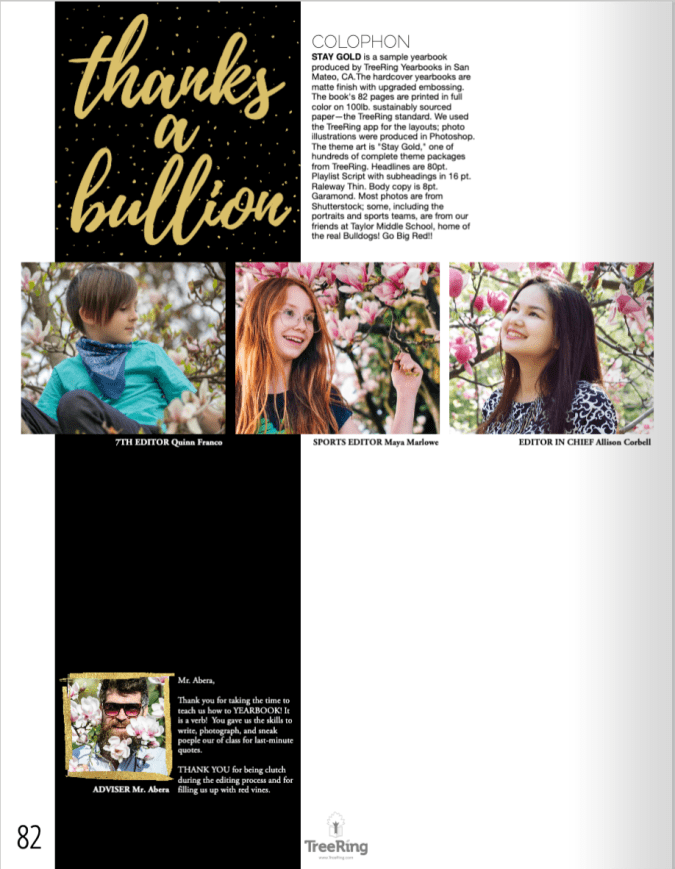
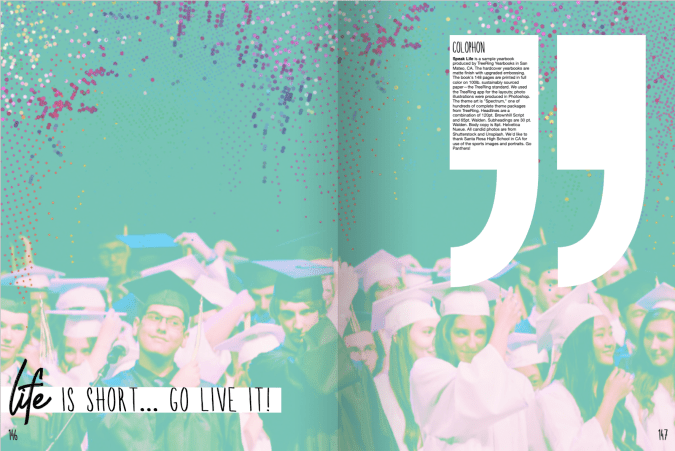
Both of these colophons leverage their themes (Stay Gold and Speak Life, respectively) with the headlines as well as the graphics. (The actual copy of their colophons is below for you to use.)
A Bold Colophon
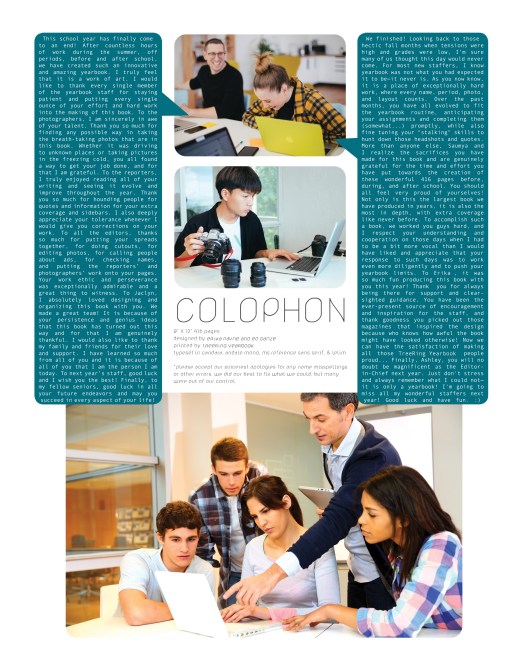
We love this one because it features the yearbook team, gives the book details in an easy-to-read format, and both editors have space to say thank you.
Yearbook Colophon Template
To create a quick colophon, copy and paste the following in your yearbook. Make it your own by giving behind-the-design details.
[Yearbook name] is produced by [School Name] in [City, State] and published by Treering Yearbooks in San Mateo, CA. The [hard- and/or softcover] yearbooks are [matte or glossy] finish [with upgraded embossing or foil]. The book's [number] pages are printed in full color on 100lb. sustainably sourced paper—the Treering standard. We used the Treering app for the layouts; [if applicable, list software used to make photo illustrations]. The theme art is [theme name from Treering] and [name] designed the cover. Headlines are [font and size] with subheadings in [font and size]. Body copy is [font and size]. [Photographer] took the school portraits and [parents, coaches, non-yearbook students] contributed [team, event, and/or candid] photos.
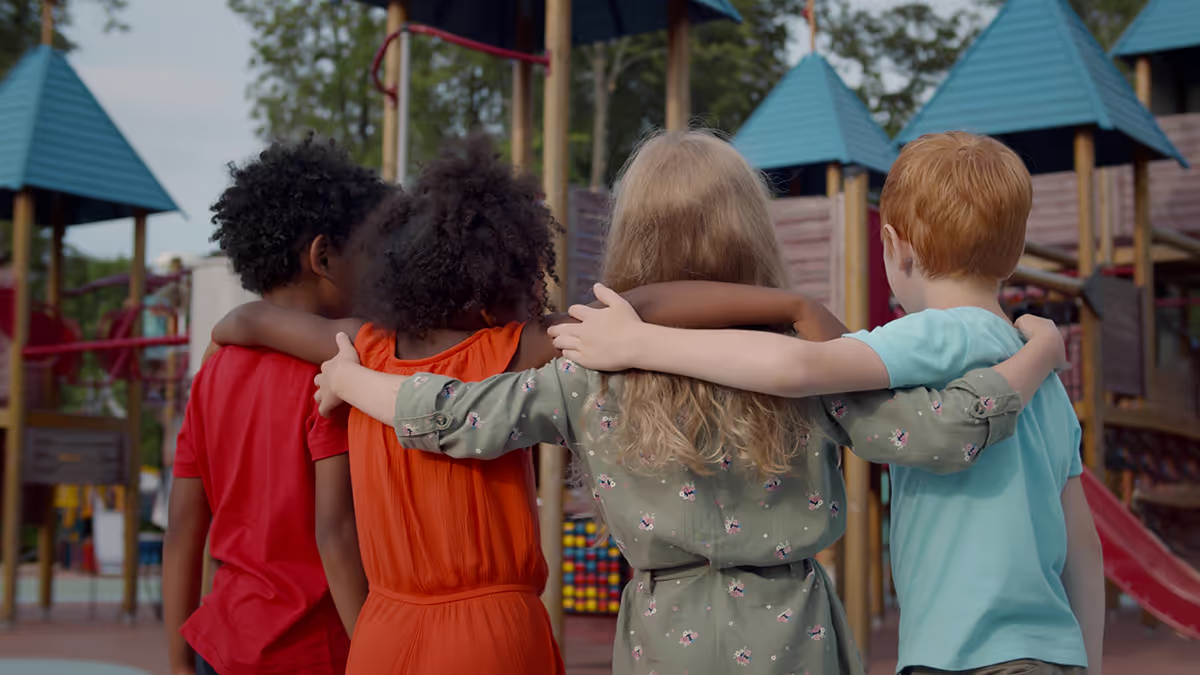
Covering natural disasters in your yearbook
As sad as it is, a lot of communities experience natural disasters, and their people must come together and rebuild. Sometimes it can be a struggle as a yearbook adviser, student editor, or team to decide whether or not to capture this historic event in your school’s yearbook, especially if you have younger students who may not fully grasp what happened. To help alleviate some of the back and forth and uncertainties, we’ve laid out a guide of best practices when covering natural disasters in your yearbook.
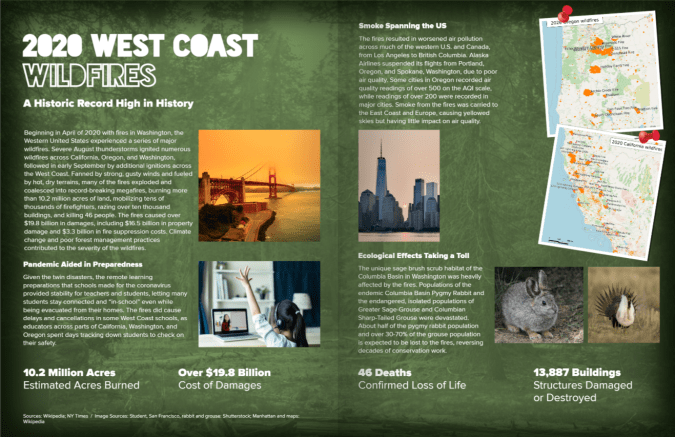
Are Natural Disasters Yearbook-Worthy?
Including current events is typically a staple for every school’s yearbook, since it is essentially a snapshot of what life was like that year. However, determining the best way to cover natural disasters, which are also considered events, isn’t always the first thing that comes to mind for yearbook editors. Or the easiest. And it’s not something for which one can completely prepare. Natural disasters can shape a school year and have an impact on everyone. Because of this, it is worth including it in the yearbook. It’s important to find uplifting ways to cover these stories when interviewing school members while respecting the boundaries of those who were impacted.
The right words and tone can emphasize how a school showcased perseverance in the face of a tragedy.
Include Accurate and Approved Information in your Coverage
Be it wildfires, tornados, hurricanes, or earthquakes, it’s critical to provide accurate information about the event. When looking back at a yearbook years from now, you don’t want the wrong date, for example, to be in print. The goal is for students to be able to look back to remember this part of their history. And ideally, the way it’s covered in the yearbook can show how the school and community overcame the crisis.
Unless you’re lucky enough to have a copyright lawyer on your yearbook committee, it’s critical to understand the basics of trademark and copyright laws when deciding on if/when to use professional photos to cover a natural disaster. You always want to make sure it’s an image you are allowed to use and that it’s free to the public. If this seems like something you don’t have time to research, instead it might be worth considering stock images that are available online, licensing images from your local newspaper, or using—with permission—photos your community has captured.
Along with photos, you should also consider the statistics to highlight. It’s important to remain sensitive and not include mentions of a death toll, for example. Instead, you can focus on other hard facts like the date(s), time, location, the scale of the natural disaster, etc. in your yearbook. If your school community collected donations, include those numbers.
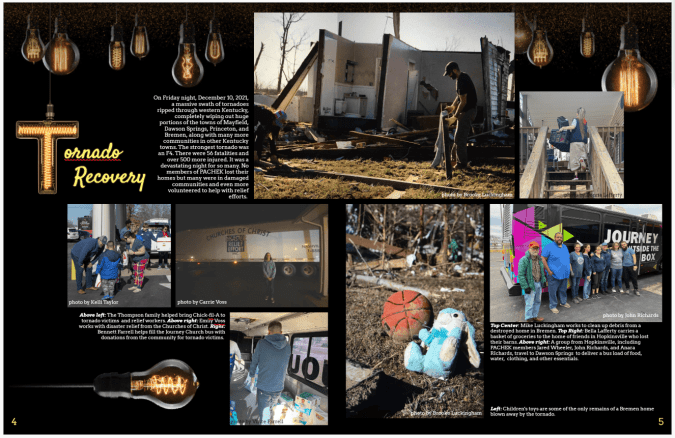
When it comes to deciding on what information to include, a great tip is to make sure that your yearbook committee has an editorial policy in place that can be shared with the community. Covering any kind of crisis can be difficult, and some may always disagree with the way you did it, so it’s best to have a written policy so that teachers, students, and parents can be aware of how the yearbook team will plan to cover a crisis like a natural disaster or a death in your school community. Get your administrator's signature on it.
Lessons Students Can Learn from Natural Disasters
A tragedy is not something anyone can overcome easily. It’s worth highlighting the hope of people within a community when they’re facing hardship together. Experiencing something of this nature becomes a part of one’s story and while it may take some extra dedicated time to determine how to showcase the lessons learned in a positive way, it’ll be beneficial to capture an impactful time such as this in a yearbook.
Interview Questions for Students and Teachers Impacted by Disasters
- How did the [natural disaster] impact the community?
- What was, or is currently, being done to help rebuild?
- Are there any stories you’re comfortable sharing about the [natural disaster’s] personal impact?
- Where were you and what were you doing as this event unfolded?
- How has the [natural disaster] impacted how you view your day-to-day life at home and at school?
- What advice would you give to students who may face a similar natural disaster crisis in the future?
- What are you grateful for after this?
- What changes did you see within the community during and after this event?

35 super awesome teacher superlatives ideas for your yearbook
35 Super Awesome Teacher Superlatives
While we’ll spend some time shortly talking about how to write your own yearbook awards for teachers, we figured we would dive right in with some ready-made ideas:- Most likely to have a new hair style/color
- Most likely to be your friend on Facebook
- Most likely to be found enjoying nature
- Most likely to bring a pet to school
- Most likely to be seen on the big screen
- Most Likely to win Jeopardy
- Most Likely to pack their bags and travel the world
- Most likely to win a rap battle
- Best advice and wisdom
- Most friendly
- Most enthusiastic
- Most likely to create world peace
- Best storyteller
- Funniest
- Most distinguishable voice
- Most school spirit
- Most Likely to Break Out in Dance
- Most Artistic
- Best Smile
- Most likely to not give weekend homework
- Most likely to have a desk full of apples
- Most likely to know the score of last night’s game
- Most Inspiring
- Most Quotable
- Most intimidating vocabulary
- Best Beard
- Best wardrobe
- Scariest death glare
- Most likely to make sarcastic comments
- Most likely to scold you and give you a detention
- Most likely to be mistaken for a student
- Most likely to scold you for eating food near the computers
- Most Likely to Be Accidentally Called Mom/Dad
- Most likely to catch a student texting in class
- Best taste in music